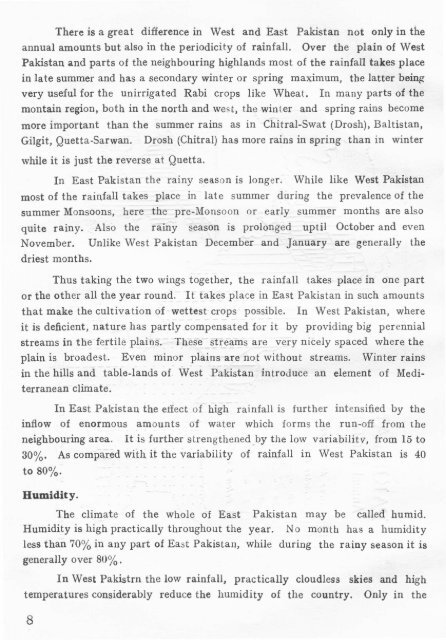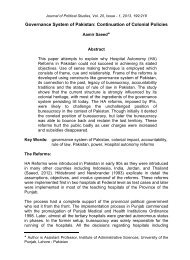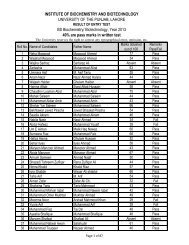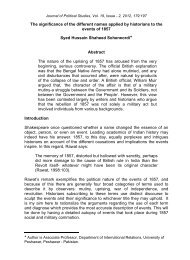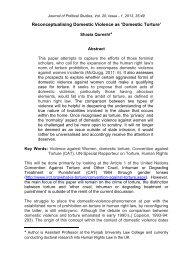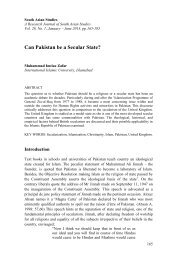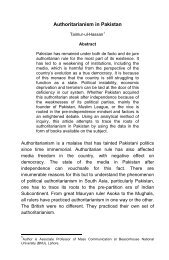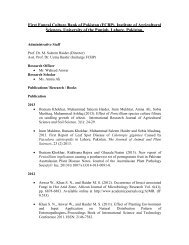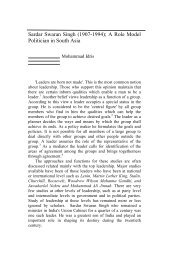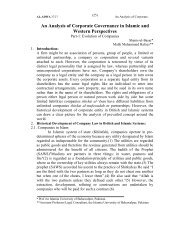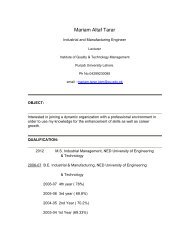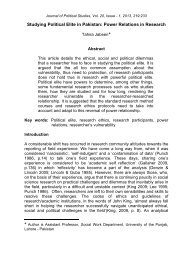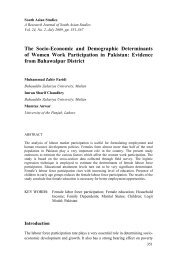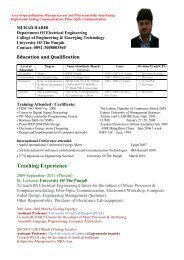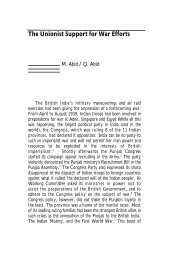pakistan geographical review 1954 - University of the Punjab
pakistan geographical review 1954 - University of the Punjab
pakistan geographical review 1954 - University of the Punjab
You also want an ePaper? Increase the reach of your titles
YUMPU automatically turns print PDFs into web optimized ePapers that Google loves.
There is a great difference in West and East Pakistan not only in <strong>the</strong><br />
annual amounts but also in <strong>the</strong> periodicity <strong>of</strong> rainfall. Over <strong>the</strong> plain <strong>of</strong> West<br />
Pakistan and parts <strong>of</strong> <strong>the</strong> neighbouring highlands most <strong>of</strong> <strong>the</strong> rainfall takes place<br />
in late summer and has a secondary winter or spring maximum, <strong>the</strong> latter being<br />
very useful for <strong>the</strong> unirrigated Rabi crops like Wheat. In many parts <strong>of</strong> <strong>the</strong><br />
montain region, both in <strong>the</strong> north and west, <strong>the</strong> winter and spring rains become<br />
more important than <strong>the</strong> summer rains as in Chitral-Swat (Drosh), Baltistan,<br />
Gilgit, Quetta-Sarwan. Drosh (Chitral) has more rains in spring than in winter<br />
while it is just <strong>the</strong> reverse at Quetta.<br />
In East Pakistan <strong>the</strong> rainy season is longer. While like West Pakistan<br />
most <strong>of</strong> <strong>the</strong> rainfall takes place in late summer during <strong>the</strong> prevalence <strong>of</strong> <strong>the</strong><br />
summer Monsoons, here <strong>the</strong> pre-Monsoon or early summer months are also<br />
quite rainy. Also <strong>the</strong> rainy season is prolonged uptil October and even<br />
November. Unlike West Pakistan December and January are generally <strong>the</strong><br />
driest months.<br />
Thus taking <strong>the</strong> two wings toge<strong>the</strong>r, <strong>the</strong> rainfall takes place in one part<br />
or <strong>the</strong> o<strong>the</strong>r all <strong>the</strong> year round. It takes place in East Pakistan in such amounts<br />
that make <strong>the</strong> cultivation <strong>of</strong> wettest crops possible. In West Pakistan, where<br />
it is deficient, nature has partly compensated for it by providing big perennial<br />
streams in <strong>the</strong> fertile plains. These streams are very nicely spaced where <strong>the</strong><br />
plain is broadest. Even minor plains are not without streams. Winter rains<br />
in <strong>the</strong> hills and table-lands <strong>of</strong> West Pakistan introduce an element <strong>of</strong> Mediterranean<br />
climate.<br />
In East Pakistan <strong>the</strong> erlect <strong>of</strong> high rainfall is fur<strong>the</strong>r intensified by <strong>the</strong><br />
inflow <strong>of</strong> enormous amounts <strong>of</strong> water which forms <strong>the</strong> run-<strong>of</strong>f from <strong>the</strong><br />
neighbouring area. It is fur<strong>the</strong>r streng<strong>the</strong>ned ,by <strong>the</strong> low variability, from 15 to<br />
30%. As compared with it <strong>the</strong> variability <strong>of</strong> rainfall in West Pakistan is 40<br />
to 80%.<br />
Humidity.<br />
The climate <strong>of</strong> <strong>the</strong> whole <strong>of</strong> East Pakistan may be called humid.<br />
Humidity is high practically throughout <strong>the</strong> year. No month has a humidity<br />
less than 70% in any part <strong>of</strong> East Pakistan, while during <strong>the</strong> rainy season it is<br />
generally over 80%.<br />
In West Pakistrn <strong>the</strong> low rainfall, practically cloudless skies and high<br />
temperatures considerably reduce <strong>the</strong> humidity <strong>of</strong> <strong>the</strong> country. Only in <strong>the</strong><br />
8


